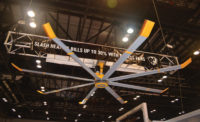“The need for makeup air is ever increasing,” said company president Patrick Reynolds. “ClimatePak was designed exclusively for problems associated with the high cost of meeting ASHRAE 62-99 ventilation requirements. It operates as a standalone unit supplying conditioned make-up air directly into the building space or to the return air stream.”
According to the company, ClimatePak delivers room-neutral air to the space, allowing the building’s existing hvac system to work at optimum efficiency, rather than compensating for swings in temperature and humidity conditions. It also is designed to reduce costly supplemental heating and cooling needed to condition the makeup air by taking advantage of the exhaust air conditions along with recovered heat from the refrigeration system, explained Reynolds.
“As the outside air cooling/ dehumidification load decreases, the ClimatePak automatically stages compressor operation down to the next level, which also reduces the amount of available reheat,” said Reynolds. “Since the required amount of reheat remains constant, the ClimatePak’s refrigerant system precisely meters the available reheat to meet leaving air design conditions.
“This strategy allows infinite temperature and humidity control under any climate conditions. The ClimatePak is so precise, it will actually meet ASHRAE 62-99 requirements for cooling supply air at maximum rh of 80%.”
Available units range from 5 to 50 tons.
COOLING TOWERS AND OTHER COMPONENTS
Other manufacturers introduced products at the expo.Baltimore Aircoil(Baltimore, MD) introduced an extended line of Series 3000 cooling towers, featuring single-cell capacities up to 1,328 tons.Protec Cooling Towers (Miami, FL) offered durable, round fiberglass cooling towers for commercial, institutional, and industrial applications. The towers are corrosion-resistant and require low maintenance, said the company.
Delta Cooling Towers (Fairfield, NJ) presented its TM Series cooling tower that expands the company’s unit capacity up to 2,000 cooling tons. The unit is designed to be energy efficient and can be configured for just about any application, it said.
Amcot Cooling Tower Corp. (Rancho Cucamonga, CA) featured cooling towers designed to make less noise. A direct-drive, low-noise motor is applied on its LRC-H 100, it said. From Model LRC-H 125 to 250 and LRC-LNS 300 to 500, the V-belt type of belt reducer is used. The company added that both types of drives feature axial flow fans “that offer silent operation and easy maintenance.”
Air Monitor (Santa Rosa, CA) showed its Volu-flo/Oam‘ outside air monitor, designed to directly measure inducted outside air. It also acts as a three-mode controller to maintain the inlet damper at the desired minimum, economizer, or external setpoint, said the company.
Buffalo Air Handling (Amherst, VA) offered the Big Buffalo, Model K, and BA2000 air-handling systems, featuring a variety of components. IAQ drain pans, full height and width diffusers, 14- and 16-gauge exterior walls, and welded floors are standard.
Calmac Manufacturing (Englewood, NJ) featured its IceBank® C-Model thermal energy storage units. The company said they feature modular, internalized main headers that can be rapidly configured in the field to reduce field piping and insulation. The installed footprint of these tanks is approximately 20% less than their predecessors, said the company.
Broad USA (Hackensack, NJ) presented its Spectrum absorption chiller/heater that provides chilling, heating, and hot water from one machine. The company said it is designed to reduce capital cost and space requirements.
FlatPlate (York, PA) offered its two-circuit brazed heat exchanger (chiller), which provides two refrigerant circuits and one fluid circuit. Company representatives likened it to a two-compressor fluid chiller. The unit has full fluid cooling even when one refrigerant circuit is off or at partial-load conditions.
Tecogen (Waltham, MA) pointed out its cogeneration modules. It is the company’s belief that cogeneration provides the most efficient form of distributed energy generation by recovering waste heat. Since engines produce waste heat at very high temperatures, capturing this heat for hot water provides end users the opportunity to lower their energy bills by as much as 40%, said a company representative. Its TecoNet™ control system was specifically developed for engine control, designed to provide fully automatic operation of its cogeneration module.
Publication date: 03/18/2002





